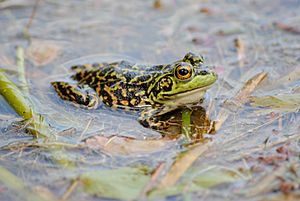Mink frog facts for kids
Quick facts for kids Mink frog |
|
|---|---|
 |
|
| Conservation status | |
| Scientific classification | |
| Genus: |
Lithobates
|
| Species: |
septentrionalis
|
| Synonyms | |
|
|
|
The mink frog (Lithobates septentrionalis) is a small type of frog that lives in the United States and Canada. It gets its name because some people say it smells like a mink. However, to others, the smell might seem more like rotting onions! This frog is also sometimes called the north frog.
Contents
What Does It Look Like?
The mink frog is a small frog. It usually grows to be about 4.8 to 7.6 centimeters (about 2 to 3 inches) long. Its back is often green with darker green or brown spots. The frog's belly is a light cream, yellow, or white color.
You can tell male and female mink frogs apart! Males usually have a bright yellow throat. Females, on the other hand, have a white throat. Also, the male's eardrum (called a tympanum) is bigger than its eye. A female's eardrum is either smaller than or the same size as her eye. These frogs also have light-colored undersides and bright green lips.
Where Do They Live and What Do They Do?
Mink frogs love water! They spend most of their lives in ponds, swamps, and streams that are near wooded areas. You can often find them among water plants, especially lily pads.
These frogs eat many different things. Their diet includes spiders, snails, beetles, and other small creatures without backbones. When they are young tadpoles, they mostly eat algae and dead plant material.
Life Cycle and Reproduction
Mink frogs usually mate in the late spring and early summer. They like to breed in cold, clean wetlands. At night, and sometimes even during the day, male frogs will call out to attract females. They do this while floating on the water or resting on plants.
A female frog can lay a lot of eggs at once, usually between 500 and 4000! She lays her eggs in deep water, often near floating plants. The eggs hatch into tadpoles just a few days after they are laid. Tadpoles stay in their larval stage for about one year. After that, they go through metamorphosis and change into small froglets. Male frogs become adults and can reproduce after one year. Females take a bit longer, reaching maturity in about two years.
Where Can You Find Them?
Mink frogs live in parts of the United States and Canada. In the U.S., you can find them in states like Minnesota, New Hampshire, Wisconsin, Michigan, Maine, Vermont, and New York. In Canada, they live in provinces such as Nova Scotia, New Brunswick, Newfoundland and Labrador, Quebec, Ontario, and Manitoba.
These frogs prefer colder places. Their southern living area is the furthest north of any North American frog. Some scientists believe that mink frog populations in more southern areas may have disappeared over the last 100 years.
Protecting Mink Frogs
In recent years, it seems that the number of mink frogs might be going down. Scientists are studying why this is happening. For example, a study in 1999 found that some mink frogs had unusual body shapes or missing parts. Scientists are trying to understand what causes these changes. More research is needed to find out for sure why some frogs are not developing normally.
| Wikisource has the text of the 1905 New International Encyclopedia article Mink-Frog. |
See also
 In Spanish: Lithobates septentrionalis para niños
In Spanish: Lithobates septentrionalis para niños


